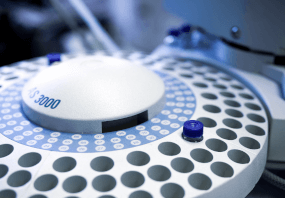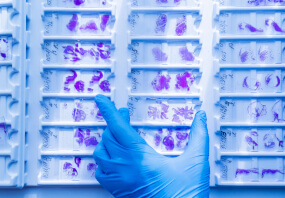General description
Epstein-Barr nuclear antigen 1 (UniProt: P03211; also known as EBNA-1, EBV nuclear antigen 1) is encoded by the EBNA1 (also known as BKRF1) gene (Gene ID: 3783709) in Epstein-Barr virus (EBV). EBV is a gamma-herpesvirus, a causative agent of infectious mononucleosis. Although the majority of virus infected individuals remain healthy, EBV has been implicated in the pathogenesis of African Burkitt s lymphoma and nasopharyngeal carcinoma. EBNA1, a multi-functional protein, plays an important role in maintaining EBV in the host cell and has been implicated in host cell immortalization. It plays an essential role in replication and partitioning of viral genomic DNA during latent viral infection. During this phase, the circular double-stranded viral DNA undergoes replication once per cell cycle and is efficiently partitioned to the daughter cells. EBNA1 activates the initiation of viral DNA replication through binding to specific sites in the viral latent origin of replication, oriP. It is also reported to direct the segregation of viral episomes by mediating their attachment to host cell metaphase chromosomes and is known to activate the transcription of several viral latency genes. By counteracting the stabilization of host p53, it also reduces apoptosis and increases host cell survival. EBNA1 is also a risk factor in a variety of malignancies and is the only viral protein found in all EBV-related malignancies. Its C-terminal region contains a dimerization domain and a DNA binding domain (aa 459-607). Although this domain is essential for its replication function of EBNA1, it is not sufficient for this activity and the N-terminal half of EBNA1 is also required.
Specificity
Clone 1H4 is a rat monoclonal antibody that detects Epstein-Barr nuclear antigen 1.
Immunogen
Lambda-cro/lacZ-EBNAl-fusion protein s emulsified with complete Freund s adjuvant.
Application
Quality Control Testing
Evaluated by Western Blotting in Raji cell lysate.
Western Blotting Analysis: A 1:1,000 dilution of this antibody detected EBNA-1 in Raji cell lysate.
Tested Applications
Western Blotting Analysis: A representative lot detected EBNA1 in Western Blotting applications (Grasser, F.A., et al. (1994). Blood. 84(11):3792-8; Humme, S., et al. (2003). Proc Natl Acad Sci USA. 100(19):10989-94; AlQarni, S., et al. (2018). Oncogene. 37(29):3998-4012).
Immunohistochemistry Analysis: A representative lot detected EBNA1 in Immunohistochemistry applications (Grasser, F.A., et al. (1994). Blood. 84(11):3792-8; Herrmann, K., et al. (2003). Breast Cancer Res. 5(1):R13-7; Chatterjee, B., et al. (2019). PLoS Pathog. 15(5):e1007748).
Immunoprecipitation Analysis: A representative lot detected EBNA1 in Immunoprecipitation applications (Schepers, A., et al. (2001). EMBO J. 20(16):4588-602).
Note: Actual optimal working dilutions must be determined by end user as specimens, and experimental conditions may vary with the end user
Anti-EBNA1, clone 1H4, Cat. No. MABF2800, is a rat monoclonal antibody that detects EBNA-1 and is tested for use in Immunohistochemistry, Immunoprecipitation, and Western Blotting.
Physical form
Purified rat monoclonal antibody IgG2a in buffer containing 0.1 M Tris-Glycine (pH 7.4), 150 mM NaCl with 0.05% sodium azide.
Storage and Stability
Recommend storage at +2°C to +8°C. For long term storage antibodies can be kept at -20°C. Avoid repeated freeze-thaws.
Other Notes
Concentration: Please refer to the Certificate of Analysis for the lot-specific concentration.
Disclaimer
Unless otherwise stated in our catalog or other company documentation accompanying the product(s), our products are intended for research use only and are not to be used for any other purpose, which includes but is not limited to, unauthorized commercial uses, in vitro diagnostic uses, ex vivo or in vivo therapeutic uses or any type of consumption or application to humans or animals.
- UPC:
- 51341903
- Condition:
- New
- Availability:
- 3-5 Days
- Weight:
- 1.00 Ounces
- HazmatClass:
- No
- MPN:
- MABF2800-100UG












